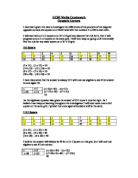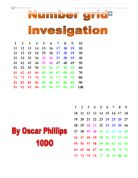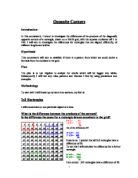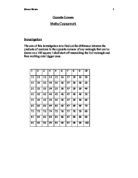Number Grid Investigation
Number Grid Question 2 3 4 5 6 7 8 9 0 1 2 3 4 5 6 7 8 9 20 21 22 23 24 25 26 27 28 29 30 31 32 33 34 35 36 37 38 39 40 41 42 43 44 45 46 47 48 49 50 51 52 53 54 55 56 57 58 59 60 61 62 63 64 65 66 67 68 69 70 71 72 73 74 75 76 77 78 79 80 81 82 83 84 85 86 87 88 89 90 91 92 93 94 95 96 97 98 99 00 Use the following rule: Find the product of the top left number and the bottom right number in the square. Do the same thing with the bottom left and top right numbers in the square. Calculate the difference between these numbers. Investigate. Method First I found the product of the top left and bottom right numbers: 23*34=782 Then I found the product of the top right and bottom left numbers: 24*33=792 Next I found the difference: 792-782=10 I then did this again for another square: 36 37 46 47 36*47=1692 37*46=1702 702-1692=10 I did this a few times and kept on getting ten as the difference. I then worked out if the difference was always ten by working out what the value of each corner in the square is relative to the top left square. X X+1 X+10 X+11 ((X+1)(X+10))-(X(X+11))=Difference (X²+10X+X+10)-(X²+11X)=Difference (X²+11X+10)-(X²+11X)=Difference Difference = 10 This shows that the difference with a 2 by 2 square is always ten when it is in a grid
Number Grid Investigation
Page No.1 Number Grid Investigation I have been asked to investigate on a number grid 10 wide 2 3 4 5 6 7 8 9 0 1 12 13 4 5 16 17 18 19 20 21 22 23 24 25 26 27 28 29 30 31 32 33 34 35 36 37 38 39 40 41 42 43 44 45 46 47 48 49 50 2x2 grids 6 7 6 7 . a) My first 2x2 grid is (6 x 17) - (7 x 16) = -10 8 9 28 29 b)My second 2x2 grid is (18 x 29) - (19 x 28) = -10 2 3 2 3 c)My third 2x2 grid is (2 x 13) - (3 x 12) = -10 24 25 34 35 d)My fourth 2x2 grid is (24 x 35) - (25 x 34) = -10 2. I predict that in the next grid the answer will be -10. 5 6 25 26 3 Test prediction- I will use the grid: (15 x 26) - (16 x 25) = -10 4. Proving the rule Y Y+1 Y + 10 Y + 11 (Y x Y + 11) - (Y + 1 x Y + 10) = (Y2 + 11) - (Y2 + 11) = 0 ` Page No.2 2 3 4 5 6 7 8 9 0 11 12 13 14 15 16 17 18 19 20 21 22 23 24 25 26 27 28 29 30 31 32 33 34 35 36 37 38 39 40 41 42 43 44 45 46 47 48 49 50 3x3 grids 4 5 6 24 25 26 34 35 36 .a) My first 3x3 grid is (14 x 36) - (16 x 34) = -40 1 2 3 21 22 23 31 32 33 b) My second 3x3 grid is (11 x 33) - (13 x 31) = -40 7 8 9 27 28 29 37 38 39 c) My third 3x3
Number Grids
Number Grids Introduction I have a10x10 grid. The task is to select various size squares and rectangles, I will then be multiplying the opposite corners together then subtracting the results to get the difference between the two answers. I hope to find patterns and rules in the results, if I can find patterns I will use algebra to describe them. My aim is to find the general rule for any size rectangle on any size grid. Plan - investigate different squares on a 10x10 grid. - Find an algebraic rule. - Repeat for rectangles on a 10x10 grid. - Adapt the rule for squares to fit rectangles. - Change the size of the grid - Find an overall rule for any rectangle on any grid. 25 26 25 x 36 = 900 35 36 26 x 35 = 910 910 - 900 = 10 The difference between the two answers is 10. 1 2 1 x 12 = 12 1 12 2 x 11 = 22 22 - 12 = 10 The difference between the two answers is 10. 72 73 72 x 83 = 5976 82 83 73 x 82 = 5986 5986 - 5876 = 10 The difference between the two answers is 10. 49 50 49 x 60 = 2940 59 60 50 x 59 = 2950 The difference between the two answers is 10. 2 13 14 12 x 34 = 408 22 23 24 14 x 32 = 448 32 33 34 448 - 408 = 40 The difference between the two answers is 40. 78 79
Number grids
In this assignment I am going to investigate about the number grid. I am going to use two different types of formula to find out the correct answers one is numerical formula and second is algebra. In numerical way I am going to multiply the top left number with right bottom number and the top right number with bottom left number and than I am going to find the difference between the products. The difference of product is going to be same as the size of a grid (in width) in 2 x 2 size. In 3 x 3 size the difference going to be four times bigger than a grid (width) size. I will also use the 5 x 5 grid, 6 x 6 grid and 7 x 7 grid to see how it works. E.g. 5 x 5 Grid 2 3 4 5 6 7 8 9 0 1 2 3 4 5 6 7 8 9 20 21 22 23 24 25 20 x 24 = 480 9 x 25 = 475 Difference between these products is 5. In algebra I am going to use different formula to find out the correct answer. This is the formula that I am going to use: n = Top left corner n + 1 = Top right corner n + 5 = Bottom left corner n + 6 = Bottom right corner (n + 1) (n + 5) - (n) (n + 6) n2 + 5n + n + 5 - n2 - 6n (n2 cancel out with - n2, 5n + n cancel out with - 6n) 5 left over This is the product difference of 2 x 2 in a 5 x 5 grid. 8 x 8 Grid 2 3 4 5 6 7 8 9 0 1 2 3 4 5 6 7 8 9 20 21 22 23 24 25 26 27 28 29 30 31 32 33 34 35 36 37 38 39 40 41 42 43
Number grids
Number grids My task is to find an algebraic rule for different sized squares in a set sized number grid. To do this I will establish my algebraic rule by creating a 10×10 square and marking out 3 different sized squares inside this square. I will then work out the rules for these individual squares and combine them to create my overall rule. 2 3 4 5 6 7 8 9 0 1 2 3 4 5 6 7 8 9 20 21 22 23 24 25 26 27 28 29 30 31 32 33 34 35 36 37 38 39 40 41 42 43 44 45 46 47 48 49 50 51 52 53 54 55 56 57 58 59 60 61 62 63 64 65 66 67 68 69 70 71 72 73 74 75 76 77 78 79 80 81 82 83 84 85 86 87 88 89 90 91 92 93 94 95 96 97 98 99 00 I have marked out my smaller squares inside the grid and will now work out an algebraic rule: To find my algebraic rule I will times the opposite corners in the inset squares and take the numbers away from each other to find the difference. 2×2- 55×66=3630 56×65=3640 3640-3630 = 10 89×100=8900 90×99=8910 8910-8900=10 22×33=726 23×32=736 736-726=10 27×38=1026 28×37=1036 036-1026=10 After multiplying the corners of the 2×2 squares I then took the lowest away from the highest. This number is always 10. In this section: a represents the number in the top left hand corner of the inset square. a a+1 a+10 a+11 (a+1)×(a+10)- a×(a+11)Here
Number Grids
Shaun Lalley 10 Bingham Maths Coursework: Number Grids 2 3 4 5 6 7 8 9 0 1 2 3 4 5 6 7 8 9 20 21 22 23 24 25 26 27 28 29 30 31 32 33 34 35 36 37 38 39 40 41 42 43 44 45 46 47 48 49 50 51 52 53 54 55 56 57 58 59 60 61 62 63 64 65 66 67 68 69 70 71 72 73 74 75 76 77 78 79 80 81 82 83 84 85 86 87 88 89 90 91 92 93 94 95 96 97 98 99 00 2 x 2 Grids I will start by investigating what happens if we take a 2x2 grid from a 10x10 master grid. I will multiply the top right number by the lower left. Then I will subtract the lower right number multiplied by the top left e.g. a b c d axd=ab cxb=cd ab-cd 2 1 2 x 12 =12 22 - 12=10 2 x 11 =22 83 84 93 94 84 x 93 =7812 7812 - 7802=10 83 x 94 =7802 89 90 99 00 90 x 99 =8910 8910 - 8900=10 89 x 100 =8900 9 0 9 20 0 x 19 =190 190 - 180=10 9 x 20 =180 The answer is always 10. I predict that my next 2 x 2 grid will result in the answer 10. 6 7 6 7 6 x 17 =102 102 - 92=10 7 x 16 =92 My prediction was correct. I will now prove that all 2 x 2 grids taken from a 10 x 10 master grid result in the answer 10, using algebra. X X+1 X+10 X+11 (X+1)(X+10) = X2 + 11X + 10 X(X + 11) =X2 + 11X (X2 + 11X + 10) - (X2 + 11X) = 10 This proves
Number grids.
Number grids. By Nicole Highfield. The aim of this investigation is to find the differences of N x N squares that are inside a 10 x 10 grid (shown bellow) then to see if there is a rule or pattern that will connect the size of the N x N to the size. To be able to find the difference of an N x N square, I will start at the smallest one, which is 2 x 2. The corners have to be multiplied together in a diagonal way. My 2 x 2 square is: - 2 x 23 = 276 3 x 22 = 286 Then to find the difference I have to minus the smallest answer from the biggest one. This is the to find the differences in all squares. 286 - 276 = 10 Using 2 x 2 array (square) of number I have found a difference between the two corners, this is a difference of ten. I will check this by doing some more 2 x 2 arrays, and work my way to bigger squares so that the investigation does not get complicated. 88 89 98 99 88 x 99 = 8712 89 x 98 = 8722 8722 - 8712 = 10 55 56 65 66 55 x 66 = 3630 56 x 65 = 3640 3640 - 3630 = 10 72 73 82 83 72 x 83 = 5976 73 x 82 = 5986 5986 - 5976 = 10 From doing these three checks I have found that the difference in a 2 x 2array is ten, to be completely sure that it is ten in any place in the 10 x 10 grid I am going to put it into a N x N formula. X X+1 X+10 X+11 This box is called an x-box and it is going to produce my N x N formula, which will
Number Grids Investigation.
2 3 4 5 6 7 8 9 0 1 2 3 4 5 6 7 8 9 20 21 22 23 24 25 26 27 28 29 30 31 32 33 34 35 36 37 38 39 40 41 42 43 44 45 46 47 48 49 50 51 52 53 54 55 56 57 58 59 60 61 62 63 64 65 66 67 68 69 70 71 72 73 74 75 76 77 78 79 80 81 82 83 84 85 86 87 88 89 90 91 92 93 94 95 96 97 98 99 00 Firstly, I will test a 2x2 grid from a 10x10 master grid. I will then find the sum of the top-left and bottom right numbers multiplied together and do the same for the top right and bottom-left numbers. 15 x 26 = 390 16 x 25 = 400 the difference between the top number and bottom number = 10 I will repeat this method again with another 2x2 grid. x 12 = 12 2 x 11 = 22 the difference between the top number and bottom number = 10 I will again follow the same method with another 2x2 grid. 85 x 96 = 8160 86 x 95 = 8170 the difference between the top number and bottom number = 10 I will now show my working in algebraic terms. n n+1 n+10 n+11 (n+1)(n+10) - n(n+11) n²+11n+10 - n²11n = 10 By working using algebra, I can see that I will always get an answer of 10 on a 2x2 grid. I will now test a 3x3 grid and carry out the same methods as before for my investigation. 1 x 23 = 23 3 x 21 = 63 the difference between the top number and the bottom number =
Number Stairs.
Number Stairs Introduction In this project I will investigate the relationship between the stair total and the position of the stair shape on the grid for three step stairs. Then I will move on to investigating the relationship between the stair totals and other step stairs on other number grids. Below is a 10x10 grid with a three step stair highlighted in yellow and another in red. 91 92 93 94 95 96 97 98 99 00 81 82 83 84 85 86 87 88 89 90 71 72 73 74 75 76 77 78 79 80 61 62 63 64 65 66 67 68 69 70 51 52 53 54 55 56 57 58 59 60 41 42 43 44 45 46 47 48 49 50 31 32 33 34 35 36 37 38 39 40 21 22 23 24 25 26 27 28 29 30 1 2 3 4 6 6 7 8 9 20 2 3 4 5 6 7 8 9 0 Strategy First we must define the variable. We will first choose the number in the bottom left hand corner of the step stair. I will call it n. I will then move the stair sequence systematically, with n increasing in tens, starting from five. This is because it is impossible to have a three step stair where n is any of the non-highlighted numbers below. Table of results n 5 5 25 35 45 55 65 75 total 74 34 94 254 314 374 434 494 The first difference between all of these is 60. We therefore know that the formula is to be a linear one. If we say that: Total = a n + b And test it using n = 5 and n = 15:
Number Stairs
Number Stairs Problem: Look at the stair shape drawn on the 10x 10 grid below. 91 92 93 94 95 96 97 98 99 00 81 82 83 84 85 86 87 88 89 90 71 72 73 74 75 76 77 78 79 80 61 62 63 64 65 66 67 68 69 70 51 52 53 54 55 56 57 58 59 60 41 42 43 44 45 46 47 48 49 50 31 32 33 34 35 36 37 38 39 40 21 22 23 24 25 26 27 28 29 30 1 2 3 4 5 6 7 8 9 20 2 3 4 5 6 7 8 9 0 This is a 3-step stair. The total of the numbers inside the stair shape is 25+26+27+35+36+45 = 194 The stair total for this 3-step stair is 194. Part 1 For other 3-step stairs, investigate the relationship between the stair total and the position of the stair shape on the grid. Part 2 Investigate further the relationship between the stair totals and other step stairs on other number grids. I plan to work first on a 10x10 grid. Let the total of the numbers within the stair be S. Let the number at the bottom left of the grid (the 'stair number') be n. On my 10x10 grid, I will first use an s-number of 25, which makes the s-total = 194. I will then work systematically, increasing the s-number by 1 every time. However, the s-number is limited in its placement - it cannot be a multiple of 10, or a multiple of 10 -1 - else it would not fit on the grid. I will record results in the following table: s-number (n) | 1 2



























